Cucina romana, di cuore e d’anarchiaRoman cuisine, of heart and anarchy
Capitale fin dal giorno della sua fondazione, Roma dovrebbe avere una cucina aristocratica e ricercata. Invece no. Avvezzi alla presenza incombente dei potenti, stimolati da un carattere disincantato e tagliente, i romani hanno percorso la strada dell’opposizione, sventolando il vessillo di una semplicità lievemente anarchica e pesantemente nemica dei fasti di corte. Ecco dunque una cucina ostentatamente popolare, anzi popolana, impegnata a ribadire la propria
semplicità proletaria e laica contro il gusto infiocchettato dei potenti. Una cucina sommessamente
rivoluzionaria e dichiaratamente ironica, come i versi di Pasquino, e che nell’impeto della dissacrazione si è lasciata andare a una certa approssimazione disordinata e caciarona.
In uno stato governato dal Papa, la cucina di contestazione non poteva che essere l’ebraica, anticlericale per definizione. E ancora oggi la cucina giudea è forse la più importante e genuina custode della tradizione gastronomica romana. Stimolati dal forte attaccamento alla loro etnia e fedeli alle loro tradizioni religiose così connesse con l’alimentazione, i ristoratori ebrei del Portico di Ottavia e delle stradine attorno alla Sinagoga rimangono i veri custodi della più antica tradizione capitolina. Andate a trovarli: vi offriranno i carciofi alla giudea, le celebri “mamme” romane trasformate in meravigliosi fiori ambrati e croccanti e le trigliette fredde con l’uvetta e i pinoli. Ma prima ancora vi proporranno l’antica pasta e broccoli col brodo di pesce. Il pesce canonico per questo piatto è l’arzilla (razza), il formato giusto di pasta è lo stortino, sorta di tubetti ricurvi che i romani in verità chiamano “cazzetti d’angelo”, e che cito a dimostrazione di quanto
sostenevo a proposito di ironia e irriverenza.
Parlando di cucina romana, comunque, il pensiero corre subito agli importantissimi contributi portati dagli antichi immigrati abruzzesi, intimamente legati a Roma e alla sua tavola dalla notte dei tempi. Amatrice, patria dell’amatriciana, oggi è un comune del Lazio, ma una volta era in Abruzzo. La sua emigrazione da una parte all’altra del confine sta quasi a dimostrare che gli scambi tra le due regioni sono talmente stretti da non limitarsi agli abbacchi e al pecorino, ma sono arrivati al punto di coinvolgere intere città. Romanizzata e parzialmente fusa con la cucina ciociara, quella abruzzese è diventata la “cucina burina” (dal burro, proveniente anch’esso dai monti della Laga e dal gran Sasso) e si è posta a fondamento della più autentica tradizione romana.
Trionfo della cucina burina sono gli spaghetti all’amatriciana (vedi), da preparare secondo le direttive della Pro Loco di Amatrice con olio di oliva, guanciale, vino bianco secco, pomodoro, peperoncino e pecorino. Parenti stretti di questo piatto gli spaghetti (o anche i rigatoni) alla gricia (o alla marchiciana) preparati come l’amatriciana ma in bianco, con l’esclusione del pomodoro.
Dalla doppia fonte abruzzese-ciociara provengono anche i rigatoni col sugo di pecora, la pasta con i ceci profumata di rosmarino e i calascioni, calzoni ripieni di pecorino, uova, bietole e verdure selvatiche.
Le erbette di campo che farciscono i calascioni sono le stesse che prendono il nome di misticanza quando, in primavera, sono consumate a tonnellate dai romani, crude in insalata, come contorno ideale dell’abbacchio a scottadito.
E’ proprio l’agnello (“abbacchio” in tutto il Lazio) il sovrano assoluto della cucina burina. Se avete fortuna, lo potete trovare eccellentemente preparato nelle sue ricette tipiche “da trattoria”: in umido con i carciofi e al forno alla romana. Non dimenticate neanche le costolette, che vi proporranno cotte velocemente alla griglia e da mangiare caldissime a “scottadito”, oppure impanate e fritte assieme ai carciofi impastellati. Oltre che dall’ebraica e dalla burina, la cucina tradizionale romana è sostenuta da altre colonne gastronomiche di uguale importanza: la macellara e la cittadina.
Cucina macellara è sinonimo del famoso “quinto quarto”. I quarti di una bestia non possono essere più di quattro, è così in tutto il mondo, ma non a Roma, dove tutto è plausibile, possibile, opinabile, persino la matematica. Dove finiscono i quattro quarti muscolari della bestia da macello, quelli ben magri e graditi al nostro gusto attuale, comincia la festa romana del quinto quarto, cioè di tutti quegli scarti di macelleria che fanno rabbrividire i fans della paillard magra e gioire i trasteverini. La pajata è intestino tenue di vitello o di agnello ancora pieno del suo contenuto di chimo. Si mangia arrosto o al sugo di pomodoro, con i rigatoni, sotto una valanga di pecorino. Le animelle sono le ghiandole linfatiche e il timo dell’animale vivo. Dopo la macellazione, diventano le protagoniste del fritto misto alla romana, assieme ai carciofi e alle cervella.
La coda del bue sapete tutti cos’è, ma meglio di voi la conoscono di certo i regolanti, gli abitanti del quartiere Regola, sulla riva sinistra del fiume, di fronte a Trastevere. Pensate che sono chiamati “magnacode” per la loro devozione alla coda alla vaccinara, se volete gustare questa specialità, ora sapete dove cercarla. Se non vi vengono i brividi, posso dirvi che la rassegna delle specialità dal quinto quarto prosegue con la milza, i rognoni, i torcioli (pancreas), i granelli (testicoli), gli schienali (midollo spinale), la coratella (insieme dei visceri toracici dell’agnello). Anche al quinto quarto del pollo sono riservati grandi onori. Le rigaglie sono l’ingrediente fondamentale del sugo per le fettuccine alla romana e costituiscono il ripieno dei supplì di riso secondo la ricetta più antica.
Più moderni sono i famosi supplì al telefono, così chiamati perchè‚ la mozzarella (provatura nel Lazio) di cui sono ripieni fila durante la degustazione e il filo tra bocca e supplì dovrebbe ricordare quello del telefono. A chi ama il maiale ricordo che appena fuori porta, ai Castelli, si celebra a ogni ora l’imperdibile rito del panino con la porchetta.
L’ultimo pilastro della cucina romana è quello squisitamente cittadino legato all’amore per gli spaghetti e nato nelle trattorie del Testaccio, di Trastevere, dei Rioni Monti e Regola. Spaghetti alla checca (con pomodoro crudo e semi di finocchio), cacio e pepe, all’aglio olio e peperoncino, alle alici, alla carrettiera, alla carbonara, queste le specialità del filone “spaghettaro”, l’acquisto più recente della complessa tradizione romana. E non poteva che essere così. Più di qualsiasi altra pasta, gli spaghetti rispondono al requisito che la cucina romana, pur nella complessità della sua storia, ha sempre richiesto a un piatto: la semplicità popolana.
Così è anche stato per i dolci, tutti semplici, proletari, quasi umili. Dal pan di Spagna inzuppato nel liquore e coperto di crema (zuppa Inglese alla romana), alle ciambellette impastate col vino, al pangiallo romano, un semplice pane dolce parente lontano e povero di quelli elaboratissimi del nord Italia. I dolci romani, semplici e veloci, fin troppo rustici per il gusto italiano, sono rimasti discretamente nascosti nelle case, nelle poche trattorie autentiche rimaste e nelle pasticcerie più popolari. Tutti, tranne il più umile, che ha conquistato notorietà nazionale a dispetto della sua austerità, è il maritozzo o quaresimale, che dichiara tutta la sua austerità già nei sui nomi: era il regalo che i fidanzati (da cui “maritozzo”) donavano alle future spose per addolcire il mesto periodo della Quaresima. E ci riuscivano, se è vero che le fidanzatine li gustavano innaffiandoli con i vini bianchi dei Castelli, così delicati e tanto beverini da riuscire a distogliere le fanciulle dalla mestizia dei giorni di Passione.
By Martino Ragusa
Capital since the day of its foundation, Roma should have an aristocratic and refined cuisine. But no. Accustomed to the looming presence of the powerful, stimulated by a disenchanted and sharp character, the Romans have traveled the road of the opposition, waving the banner of a slightly anarchic simplicity, heavily enemy of the glories of the court. So here a kitchen ostensibly popular, even common people, committed to reiterate its proletarian and laic simplicity against the beribboned taste of the mighty. A submissively revolutionary and overtly ironic cuisine, as the verses of Pasquino, and that in the heat of desecration has indulged in some disorderly and “caciarona” approximation.
In a state governed by the Pope, the cuisine of contestation could only be Jewish, anti-clerical by definition. And still today the Jewish cuisine is perhaps the most important and genuine guardian of Roman culinary tradition. Stimulated by strong attachment to their ethnic and faithful to their religious traditions so connected with the supply, the Jews restaurateurs of the Portico of Octavia and streets around the synagogue are the true custodians of the oldest City tradition. Go and find them: will offer the Jewish style artichokes, the famous “mothers” Roman turned into wonderful amber and crisp flowers and the cold red mullet with raisins and pine nuts.
But before they will propose you the ancient pasta and broccoli with fish stock. The canonical fish for this dish is the “arzilla” (ray), the right format for pasta is the stortino, sort of curved small tubes that the Romans actually called “angel cocks”, that I quote demonstrating how I argued about irony and irreverence.
Speaking of Roman cuisine, however, the thoughts turn to the important contributions made by the ancient immigrants from Abruzzo, intimately linked to Rome and to his table from the mists of time. Amatrice, home dell’amatriciana, today is a town in the Lazio region, he was once in Abruzzo. His emigration from one side of the border is about to prove that trade between the two regions are so narrow as not limited to “abbacchi” and pecorino cheese, but they are got to the point of involving entire cities. Romanized and partially merged with the “ciociara” cuisine, the Abruzzo became the “burina (hick) cuisine” (from butter, also coming from the mountains of Laga and the Gran Sasso) and has set the foundation of authentic Roman tradition.
Triumph of the burina cuisine are the spaghetti amatriciana (see), to be prepared according to the guidelines of the Pro Loco of Amatrice with olive oil, bacon, white wine, tomato, chili and cheese. Close relatives of this dish are the spaghetti (or rigatoni) alla gricia (or marchiciana) prepared as amatriciana but in white, with the exclusion of the tomato.
From the double-source abruzzese-ciociara also come the rigatoni with sheep sauce, the pasta with chickpeas rosemary-scented and the “calascioni”, calzone stuffed with cheese, eggs, beets and wild vegetables.
The wild herbs stuffing the calascioni are the same that are called misticanza when, in the spring, are consumed by the ton by the Romans, raw in salads, as a garnish ideal dell’ “abbacchio a scottadito (finger burn)”. It is just the lamb (“abbacchio” in the Lazio) the absolute ruler of the hick kitchen. If you are lucky, you can find excellently prepared in his “trattoria” recipes : stew with artichokes or baked Roman style. Do not forget either the prime rib, which will offer you quickly cooked on the grill and eat very hot in “scottadito”, or breaded and fried with artichokes. Besides the jewish and the hick, the traditional Roman cuisine is supported by other gastronomic columns of equal importance: the “macellara” (butcher style) and the town.
Macellara cuisine is synonym for the famous “fifth quarter”. The quarter of a beast can not be more than four, it’s so all over the world, but not in Rome, where everything is plausible, possible, questionable, even mathematics. Where they end up the four muscolar quarters of the beast for the slaughter, those well lean and welcome to our present taste, begins the Roman festival of the fifth quarter, ie all those wastes of butchery who make shudder the fans of the lean paillard and fill of joy the trasteverini. Pajata is the small intestine of veal or lamb still full of its content of chyme. You eat roast or with tomato sauce, with rigatoni, under an avalanche of pecorino. The sweetbreads are the thymus and lymph glands of the live animal. After slaughter, they become the protagonists of the mixed fry Roman style, along with artichokes and brains.
The ox tail all know what it is, but better than you know it certainly the regolanti, people in the neighborhood of Regola, on the left bank of the river, in front of Trastevere. Do you think they are called “magnacode” (oxtail eaters) for their devotion to the oxtail, if you want to taste this specialty, now you know where to look. If you do not shudder, I can tell you that the review of the specialties from the fifth quarter continues with the spleen, kidneys, the torcioli (pancreas), grains (testicles), the backs (spinal cord), the offal (the thoracic viscera of the lamb). Even to the fifth quarter of the chicken are reserved great honors. The giblets are the key ingredient of the sauce for the fettuccine Roman style and the filling up of rice supplì according to the older recipe.
More modern are the famous supplì on the phone, so called because, the mozzarella (provatura in the Lazio region) of which are filled “string” during the tasting and the wire between the mouth and supplì should remember that of the phone. To those who love the pig remember just outside the door, to the Castelli, it is celebrated every hour the unmissable rite of the sandwich with porchetta.
The last pillar of Roman cuisine is exquisitely citizen, related to love for spaghetti and born in the trattorias of Testaccio, Trastevere, of the Rioni Monti and Regola. Spaghetti alla checca (with raw tomato and fennel seeds), cheese and pepper, garlic oil and chilli pepper, with anchovies, alla carrettiera, carbonara, these specialties of the lodging “spaghettaro”, tare he most recent purchase of the complex Roman tradition. It could not be otherwise. More than any other pasta, the spaghetti respond to the requirement that the Roman cuisine, despite the complexity of its history, has always required a plate: the commoner simplicity.
So it was also for the desserts, all simple, proletarians, almost humble. The pan di Spagna soaked in liqueur and covered with cream (English soup Roman style), the ciambellette mixed with the wine, the Roman pangiallo, a simple sweet bread, poor and distant relative of those highly elaborate of northern Italy. Romans sweets, simple and fast, too rustic for the Italian taste, remained discreetly hidden in homes, in the few remaining authentic taverns and patisseries most popular patisseries. All except the most humble, who won national fame in spite of its austerity, is the maritozzo or Lenten, declaring all its austerity already in the names: it was the gift that the engaged couple (hence “maritozzo”) donated to future brides to sweeten the sad period of Lent.
And they succeeded, If it is true that the girlfriends enjoy watering them with the white wines of the Castelli, so delicate and so drinkable to be able to distract the girls from the sadness of the days of the Passion.





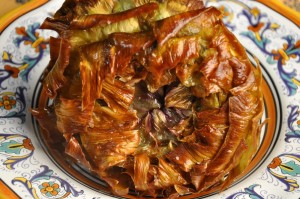
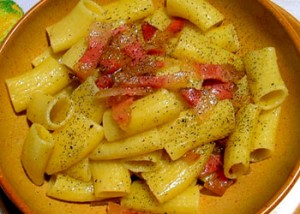

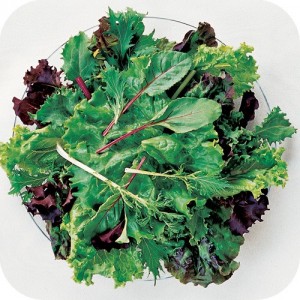
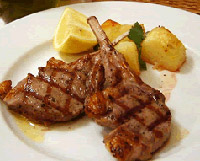
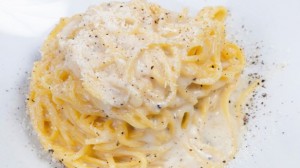

Leave a comment